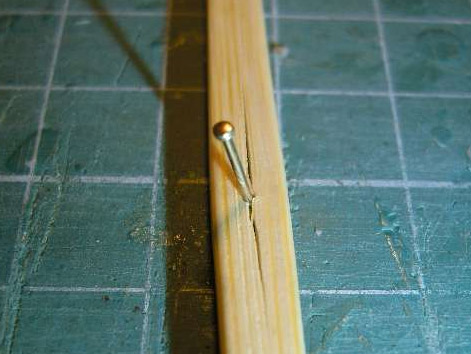 Hanging sharp nails into thin slats usually ends with a longitudinal crack from the forehead, even then, when the rejoice site is a little distant from the forehead. Just the sharp end of the nail separates the wood along the grain. You can protect yourself against this by breaking the sharp tip of the nail with a hammer. A small feast will form on the blade, who will be crushing the jars of wood when driving, instead of splitting. The fever will not worsen the conditions of hammering the nail deeper.
Hanging sharp nails into thin slats usually ends with a longitudinal crack from the forehead, even then, when the rejoice site is a little distant from the forehead. Just the sharp end of the nail separates the wood along the grain. You can protect yourself against this by breaking the sharp tip of the nail with a hammer. A small feast will form on the blade, who will be crushing the jars of wood when driving, instead of splitting. The fever will not worsen the conditions of hammering the nail deeper.
Breaking up
With the front connecting of two tongs in the shape of the letter T, you need to create resistance for a vertical post. With this combination of the nail, we put it obliquely. Obvious forces also causes the vertical pillar to move from the connection where the hammer strikes strokes. Resistance will prevent this. With elements with small cross -sections, a carpentry squeeze can be used for such resistance, preferably screw, which we tighten very strongly on a horizontal beam, by putting his arm to the postparty.
Painting holder
If we want to paint a wooden frame at the same time, e.g.. from the picture from all sides, This is what we must ensure the place of hold, which will not be painted. A wooden slat to the bottom of the frame can be used for such a handle. We keep behind her during all the painting. After the paint has dried, it will be easy to tear it off and only paint the surfaces with a small brush at the position of the slat. While drying the paint.
Hacking dowels
Wooden connecting pegs must not be stuck in the forehead of the chipboard. When applying too much glue in the hole, The hammered stake can cause its longitudinal fission. Therefore, each narrow plate must first be tightened in the vivid jaws, Remembering the ground between the jaw and the plate of wooden protective pads. When the plate is particularly larger, grabbing the plate in the place of hammering the dowel. Here, too, you have to remember about protective pads.
Oblique hammer
When joining wooden elements, e.g.. episodes of the boards, set perpendicularly you have to reckon with this, that nails can come out of the lower element, In this element, we stick them along the wood grain, and this is not a certain attachment. We will get a much greater attachment power, If all nails stuck along one line are stuck obliquely at different angles and in different directions relative to the lines of the jar.